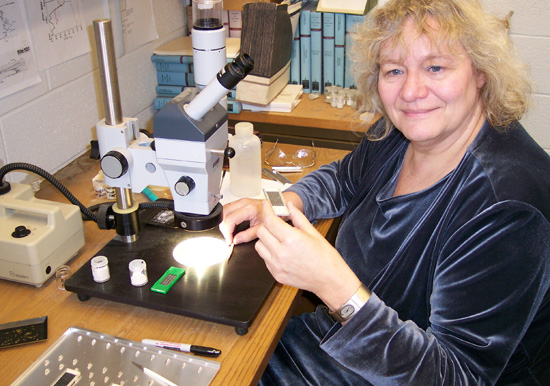Research Professor Examines Greenhouse Emissions in Deep Sea Biota at National Symposium
 |
|
Ellen Thomas, research professor of earth and environmental sciences, examines the fossils of sea creatures from her office in Exley Science Center. Thomas extracted her samples from the ocean’s floor. She says they are more than 65 million years old. |
| Posted 03/01/06 |
| The largest habitat on Earth lies hundreds to thousands of feet beneath sea level, in a dark, near-freezing, high-pressure environment with little food.
About 65 million years ago, the life forms living on the ocean-floor in this habitat survived the an asteroid impact, which probably wiped out the dinosaurs and many other forms of life on land and in the sea. But 55 million years ago, an episode of rapid global warming caused extinction of a third to half of the species of sea-bottom dwellers. Ellen Thomas, research professor of earth and environmental sciences, argues that fossils from these unicellular sea creatures can help in understanding how the biota would react to another onslaught of global warming caused by a rapid emission of greenhouse gases. In general, deep-sea benthic foraminifera do not easily suffer large extinction; most of them are cosmopolitan, and can survive local environmental problems in a refugium somewhere in the world’s oceans, Thomas explains. The extinction was most probably caused by metabolic and ecosystem restructuring due to rapid global warming, she says. Thomas recently presented her ideas in an American Association for the Advancement of Science (AAAS) symposium on the topic Ancient Greenhouse Emissions and Hothouse Climates, held Feb. 17 in St. Louis, Mo. The AAAS is an international non-profit organization dedicated to advancing science around the world. In this session, Thomas and six other experts examined the major periods of hothouse climates and their associated greenhouse gas levels from a geological perspective and integrated geologic, chemical, and biologic proxy records. Thomas discussed Deep-Sea Biota: Consequences of Massive Greenhouse Gas Emissions, and recalled the global warming episode about 55 million years ago. During this period, the planets temperature rapidly rose between 9 and 16 degrees F in a short period of time. Deep-sea biota are so poorly known so that we can not predict their reaction to direct and indirect effects of increasing atmospheric CO2 levels, but their fossil remains can be used to study the behavior of deep-sea biota during global warming, Thomas explains. Thomas joined speakers from Pennsylvania State University, Woods Hole Oceanographic Institute, Northwestern University, University of California, Santa Cruz, Columbia University, Rice University and The Smithsonian Museum of Natural History. The speakers joint argument was that this period of natural global warming can be used as an example to give scientists valuable information on what happens to the planet and its life during such episodes of greenhouse warming. After debating, the speakers concluded that it is possible that climate sensitivity to increased levels of CO2 in the atmosphere is larger than specified in most commonly used climate models. It is thus possible that the earth will warm up more than presently expected as a response to anthropogenic greenhouse gas emissions. The sessions were attended by scientists, but also journalists, teachers and others simply interested in science. Because the symposium was spread out over four days, Thomas was able to attend other presentations outside of her field of expertise. I attended highly interesting, interdisciplinary sessions on intelligent design, scientific integrity, and a session on political and economic aspects of climate change in the near future, she says. Thomas also was selected to be an interviewee at the AAAS-organized press conference prior to her talk. She and four other speakers gave brief introductions to their research and answered questions from journalists. Thomas spoke to reporters from the AAAS paper ‘Science’, and other non-science media such as The Economist from the United Kingdom, a Swedish newspaper, and two Dutch TV-radio stations. Thomas, who is originally from The Netherlands, spoke to these reporters in Dutch. They were very thrilled to be able to interview someone who is from Holland and could speak in Dutch, she says. I had not realized what a large international press representation there was going to be. AAAS President Gilbert Omenn says the symposiums program was designed to challenge scientists, engineers, teachers and citizens to frame important scientific and societal problems in ways that create opportunities to apply the best in science and technology for broad benefit. We can mobilize individual disciplines and cross-disciplinary work on major national and global goals, he said. We can boldly define problems and potential solutions for the decades ahead, thereby inspiring the scientific and engineering community and attracting young people to this mission. |
| By Olivia Drake, Wesleyan Connection editor |

